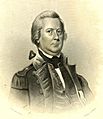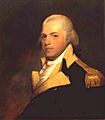Battle of Bull's Ferry facts for kids
Quick facts for kids Battle of Bull's Ferry |
|||||||
|---|---|---|---|---|---|---|---|
| Part of the American Revolutionary War | |||||||
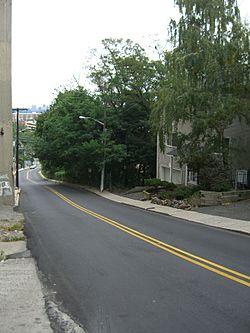 Bulls Ferry Road descends from the top of the Hudson Palisades down to the river. |
|||||||
|
|||||||
| Belligerents | |||||||
| Commanders and leaders | |||||||
| Strength | |||||||
| Almost 2,000 | 70 | ||||||
| Casualties and losses | |||||||
| 15 killed, 49 wounded | 5 killed, 16 wounded | ||||||
The Battle of Bull's Ferry was a small fight during the American Revolutionary War. It happened on July 20 and 21, 1780, in Bulls Ferry, New Jersey. American soldiers, led by General Anthony Wayne, attacked a small fort (called a blockhouse). This fort was defended by Loyalist Americans, who were colonists loyal to Britain. They were led by Thomas Ward.
The Americans tried to break into the blockhouse but failed. However, American cavalry, led by Major Light Horse Harry Lee, successfully took many cattle. These cattle were being kept for the British army in New York City. This event inspired a British officer, Major John André, to write a funny poem called The Cow Chace. At this point in the war, most fighting in the northern states involved small raids and skirmishes.
Background to the Battle
After the Battle of Monmouth in June 1778, the main American and British armies didn't have any more big battles in the northern states. General George Washington moved his army to block the British in New York City. This blockade lasted for the rest of the war.
In July 1778, a French fleet arrived near New York. This was a chance for the Americans and French to trap the British. However, the French ships were too big to cross a shallow sandbar. So, the French admiral, Charles Hector, comte d'Estaing, sailed away. A great chance to end the war early was missed.
Even though there were no huge battles, smaller fights and raids continued. For example, in 1779, American forces had some important victories. General Anthony Wayne led a surprise attack at the Battle of Stony Point. Also, Light Horse Harry Lee led a successful raid at the Battle of Paulus Hook.
In late 1779, the British commander, Sir Henry Clinton, took many of his troops south. He wanted to attack Charleston, South Carolina. He left about 10,000 soldiers to defend New York. In May 1780, the British captured Charleston. This was a huge loss for the Americans. Many American soldiers were taken prisoner.
While Clinton was in the south, the British general Wilhelm von Knyphausen led raids in New Jersey. In June 1780, he tried to attack Morristown, New Jersey, where the Americans had a base. American forces, led by General Nathanael Greene, fought bravely. They slowed the British advance. Knyphausen eventually pulled his troops back to Staten Island.
The Battle at Bull's Ferry
On July 20, 1780, General Washington ordered General Wayne to attack a British blockhouse. A blockhouse is a small, strong fort, often made of logs. This one was at Bulls Ferry, across from New York City. Wayne took about 2,000 American soldiers, including two brigades and four cannons. He also had cavalry (soldiers on horseback) led by Stephen Moylan.
The blockhouse was defended by about 70 Loyalists. They were led by Thomas Ward. The British used this area to cut wood and keep cattle. The blockhouse protected these operations from American attacks.
Wayne had two main goals for this mission. First, he wanted to destroy the blockhouse. Second, he wanted to capture the cattle and horses that the British kept nearby. These animals were important for feeding the British army in New York. Wayne sent his cavalry, led by Harry Lee, to round up the cattle. Meanwhile, Wayne took three regiments and the cannons to attack the blockhouse.
Early on July 21, Wayne's cannons began firing at the blockhouse. But after an hour, the cannons didn't seem to do much damage. The Loyalists inside the blockhouse fired back accurately. The American soldiers became impatient. Despite their officers trying to stop them, the soldiers rushed forward. They tried to get through the defenses to the base of the fort. But they couldn't break in. They were forced to retreat.
What Happened After
The Battle of Bull's Ferry had two main outcomes: some soldiers died, and the Americans captured cattle. General Wayne reported that 15 American soldiers were killed. Three officers and 46 other soldiers were wounded. The British commander, Clinton, said that 21 Loyalists were hurt. He also noted that 50 cannonballs hit the blockhouse.
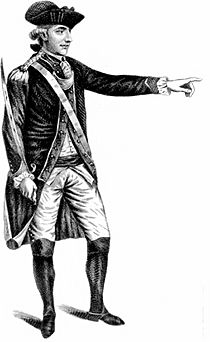
Major John André wrote a funny poem about the battle called The Cow Chace. In his poem, André made fun of the American claims that their cannonballs couldn't damage the blockhouse. He wrote:
No shot could pass, if you will take
The General's word for true;
But 'tis a d(amna)ble mistake,
For every shot went through.
Lee's cavalry successfully gathered a large number of cattle. They brought them back to Washington's army camp. Wayne also burned the boats used by the British woodcutters. He captured some of the boatmen. André's poem also mentioned that Colonel Thomas Proctor was in charge of Wayne's cannons during the battle.
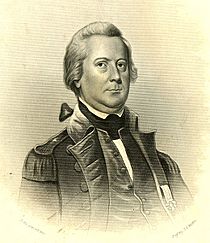
André also made fun of American General William Irvine, who fought at Bull's Ferry. André joked that Irvine was in charge of the difficult attack on the blockhouse. Meanwhile, Wayne and Lee had the easier job of stealing cattle.
At Irving's nod 'twas fine to see,
The left prepare to fight;
The while, the drovers, Wayne and Lee,
Drew off upon the right.
André continued to mock Irvine's retreat:
Irving and terror in the van,
Came flying all abroad;
And cannon, colors, horse, and man,
Ran tumbling to the road.
Still as he fled, 'twas Irving's cry,
And his example too,
"Run on, my merry men – For why?
The shot will not go through."
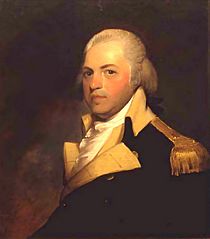
André even made a joke about William Alexander, Lord Stirling, who wasn't even at the battle. He teased Wayne about his past job as a tanner (someone who prepares animal hides).
To drive the kine one summer's morn,
The tanner took his way;
The calf shall rue that is unborn,
The jumbling of that day.
The poem ends with André joking that he hopes Wayne, the "warrior-drover," doesn't catch him for writing the poem.
Images for kids




